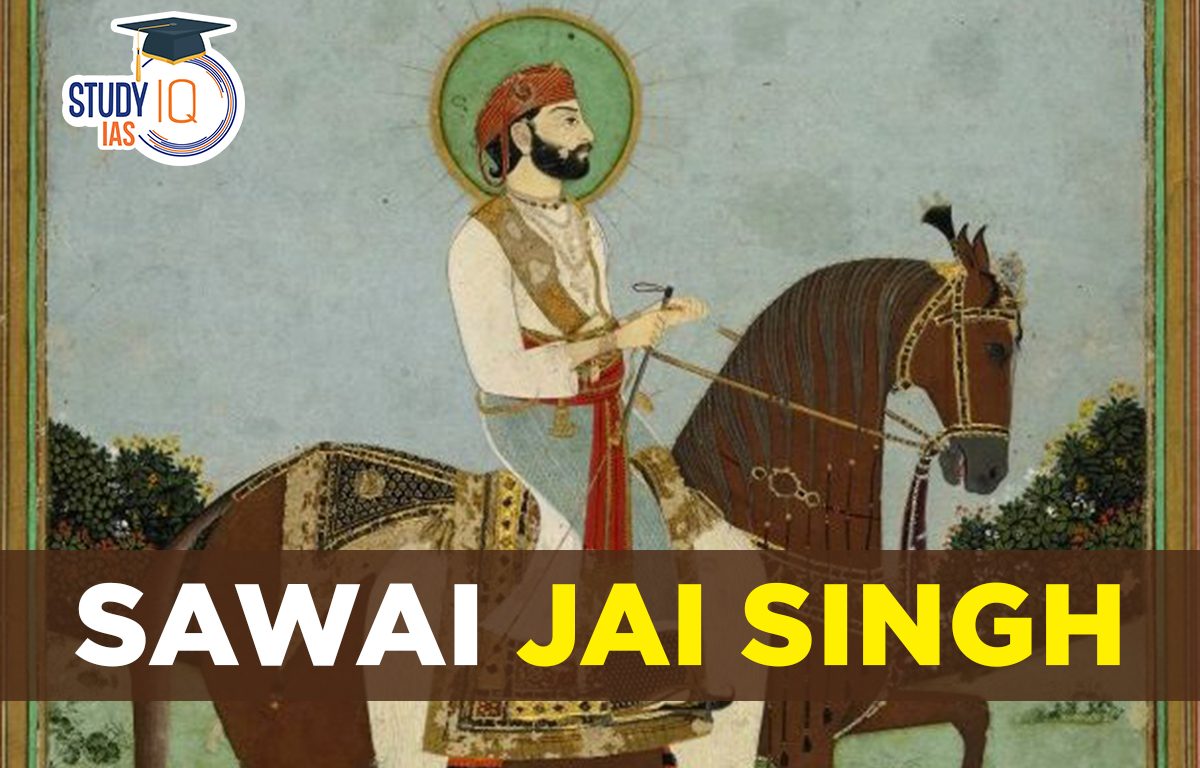Table of Contents
Sawai Jai Singh
Raja Sawai Jai Singh of Amber was the most notable Rajput king of the 18th century (1681-1743). A notable statesman, legislator, and reformer, he was. In an era when Indians were ignorant of scientific advancement, he excelled best as a man of science. In the territory seized from the Jats, he created the city of Jaipur and turned it into a significant centre of science and art.
Jaipur was constructed using only rational, scientific concepts and in accordance with a schedule. Right angles cross the city’s wide roadways. Students can learn everything there is to know about Sawai Jai Singh’s UPSC exam preparation in this post.
Read about: Nadir Shah
Sawai Jai Singh Early Life
Sawai Jai Singh was the Rajput monarch of the Amber kingdom (later called Jaipur). The Kachwahas’ capital city, Amber (now Jaipur), is where he was born. After his father Maharaja Bishan Singh passed away on December 31, 1699, at the age of 11, he was crowned king of Amber.
The Mughal emperor Muhammad Shah gave him the title of Saramad-i-Rajaha-i-Hind on April 21, 1721, and on June 2, 1723, the emperor also gave him the titles of Raj Rajeshvar, Shri Rajadhiraj, and Maharaja Sawai. “Sawai” translates to one and a half times better than his contemporaries.
The social and political strife among the many states in the British India Region piqued Sawai Jai Singh, a Rajput ruler, from a young age. In terms of war culture, Sawai Jai Singh was extremely intelligent. In terms of social and political matters, he was also quite clever. The monarch was greatly inspired by Jagannatha, his astronomer, and he recommended that Jantar Mantar be built in Jaipur.
Sawai Jai Singh imagined that European astronomers had employed telescopes to track the motion of stars and planets at the start of the seventeenth century. He adhered to the theory of naked eye observation, which held that natural phenomena were the fundamental instinct of culture and contributed to the improvement of the local culture.
Famous foreign astronomers were called by Sawai Jai Singh to a conversation, and his region enjoyed political stability and strong relations with both local and British rulers. The fields of astrology, mathematics, and architecture have all benefited greatly from Sawai Jai Singh’s contributions. Prior to him, neither the astrological notion nor its commercial use in any architectural design was particularly well-known in the British India Region.
Read about: Ahmad Shah Abdali
Sawai Jai Singh Observatories
Sawai Jai Singh created several observatories during his reign, and in the late eighteenth century, he built five significant ones, mostly in the northern section of the British India Region. The most significant observatory established by Sawai Jai Singh is presently located in New Delhi and is called Jantar Mantar.
According to this architecture, an architectural intelligence was formed in various places of India. The additional portion of the Amer fort was erected by Sawai Jai Singh, whose fundamental portion was constructed by Rajput king Raja Man Singh. Sawai Jai Singh also constructed Vedhshala in the cities of Jaipur and Ujjain in the year 1719. Most observatories were constructed by Sawai Jai Singh using a variety of astronomy techniques as well as cosmological ideas.
Read about: Bahadur Shah I
Sawai Jai Singh Jantar Mantar
13 various architectural devices with astronomical viewpoints make up Sawai Jai Singh Jantar Mantar, which is principally located in New Delhi. Between the years of 1724 and 1735, Sawai Jai Singh built a total of five Jantar Mantar in the cities of New Delhi, Jaipur, and Ujjain.
Both Mathura and Varanasi have additional Jantar Mantars. The main goal of constructing this observatory was to compile a variety of astronomical tables that are essential for predicting time as well as the motion of other celestial bodies, such as the position of the sun and moon and the motion of other planets. In terms of astronomical observation, Jantar Mantar included 20 various stationary instruments.
High-level astronomical knowledge and diverse cosmological ideas, which were also present in other Mughal-era architectural styles, were used exclusively in the construction of Jantar Mantar. The fundamental idea behind constructing the Jantar Mantar was “Ptolemaic positional astronomy.”
Read about: Jahandar Shah
Sawai Jai Singh UPSC
With the help of the Mughal Emperor, Sawai Jai Singh rose to become one of the most powerful kings of his time. He took the Vishalgarh fort from the Maratha king in the year 1701, and in the year 1712 the Vishalgarh fort was formally acknowledged as the Imperial Edict of the Rajput king Sawai Jai Singh. The Rajput king Sawai Jai Singh enjoyed a variety of literary genres, including astronomy, architecture, and literature. He was extremely fond of mathematics.
Read about: Farrukh Siyar


 Story of Meera Bai and Her Devotion For ...
Story of Meera Bai and Her Devotion For ...
 Desert Climate, Distribution, Climatic C...
Desert Climate, Distribution, Climatic C...
 Deserts of India Map, Features of Thar D...
Deserts of India Map, Features of Thar D...





















